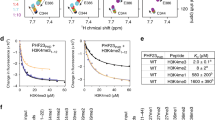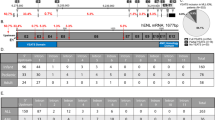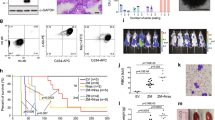Abstract
Recurrent chromosomal translocations involving the mixed lineage leukaemia (MLL) gene initiate aggressive forms of leukaemia, which are often refractory to conventional therapies1. Many MLL-fusion partners are members of the super elongation complex (SEC), a critical regulator of transcriptional elongation, suggesting that aberrant control of this process has an important role in leukaemia induction2,3. Here we use a global proteomic strategy to demonstrate that MLL fusions, as part of SEC2,3 and the polymerase-associated factor complex (PAFc)4,5, are associated with the BET family of acetyl-lysine recognizing, chromatin ‘adaptor’ proteins. These data provided the basis for therapeutic intervention in MLL-fusion leukaemia, via the displacement of the BET family of proteins from chromatin. We show that a novel small molecule inhibitor of the BET family, GSK1210151A (I-BET151), has profound efficacy against human and murine MLL-fusion leukaemic cell lines, through the induction of early cell cycle arrest and apoptosis. I-BET151 treatment in two human leukaemia cell lines with different MLL fusions alters the expression of a common set of genes whose function may account for these phenotypic changes. The mode of action of I-BET151 is, at least in part, due to the inhibition of transcription at key genes (BCL2, C-MYC and CDK6) through the displacement of BRD3/4, PAFc and SEC components from chromatin. In vivo studies indicate that I-BET151 has significant therapeutic value, providing survival benefit in two distinct mouse models of murine MLL–AF9 and human MLL–AF4 leukaemia. Finally, the efficacy of I-BET151 against human leukaemia stem cells is demonstrated, providing further evidence of its potent therapeutic potential. These findings establish the displacement of BET proteins from chromatin as a promising epigenetic therapy for these aggressive leukaemias.
This is a preview of subscription content, access via your institution
Access options
Subscribe to this journal
Receive 51 print issues and online access
$199.00 per year
only $3.90 per issue
Buy this article
- Purchase on Springer Link
- Instant access to full article PDF
Prices may be subject to local taxes which are calculated during checkout




Similar content being viewed by others
Change history
27 October 2011
The spelling of author name Antje Dittmann was corrected.
References
Krivtsov, A. V. & Armstrong, S. A. MLL translocations, histone modifications and leukaemia stem-cell development. Nature Rev. Cancer 7, 823–833 (2007)
Lin, C. et al. AFF4, a component of the ELL/P-TEFb elongation complex and a shared subunit of MLL chimeras, can link transcription elongation to leukemia. Mol. Cell 37, 429–437 (2010)
Yokoyama, A., Lin, M., Naresh, A., Kitabayashi, I. & Cleary, M. L. A higher-order complex containing AF4 and ENL family proteins with P-TEFb facilitates oncogenic and physiologic MLL-dependent transcription. Cancer Cell 17, 198–212 (2010)
Milne, T. A. et al. Multiple interactions recruit MLL1 and MLL1 fusion proteins to the HOXA9 locus in leukemogenesis. Mol. Cell 38, 853–863 (2010)
Muntean, A. G. et al. The PAF complex synergizes with MLL fusion proteins at HOX loci to promote leukemogenesis. Cancer Cell 17, 609–621 (2010)
Rodríguez-Paredes, M. & Esteller, M. Cancer epigenetics reaches mainstream oncology. Nature Med. 17, 330–339 (2011)
Nicodeme, E. et al. Suppression of inflammation by a synthetic histone mimic. Nature 468, 1119–1123 (2010)
Filippakopoulos, P. et al. Selective inhibition of BET bromodomains. Nature 468, 1067–1073 (2010)
Chung, C. W. et al. Discovery and characterization of small molecule inhibitors of the BET family bromodomains. J. Med. Chem. 54, 3827–3838 (2011)
Bantscheff, M. et al. Chemoproteomics profiling of HDAC inhibitors reveals selective targeting of HDAC complexes. Nature Biotechnol. 29, 255–265 (2011)
Jang, M. K. et al. The bromodomain protein Brd4 is a positive regulatory component of P-TEFb and stimulates RNA polymerase II-dependent transcription. Mol. Cell 19, 523–534 (2005)
Maruyama, T. et al. A mammalian bromodomain protein, Brd4, interacts with replication factor C and inhibits progression to S phase. Mol. Cell. Biol. 22, 6509–6520 (2002)
Yang, Z. et al. Recruitment of P-TEFb for stimulation of transcriptional elongation by the bromodomain protein Brd4. Mol. Cell 19, 535–545 (2005)
Somervaille, T. C. et al. Hierarchical maintenance of MLL myeloid leukemia stem cells employs a transcriptional program shared with embryonic rather than adult stem cells. Cell Stem Cell 4, 129–140 (2009)
Wang, J. et al. Conditional MLL-CBP targets GMP and models therapy-related myeloproliferative disease. EMBO J. 24, 368–381 (2005)
Robinson, B. W. et al. Abundant anti-apoptotic BCL-2 is a molecular target in leukaemias with t(4;11) translocation. Br. J. Haematol. 141, 827–839 (2008)
Wang, Q. F. et al. MLL fusion proteins preferentially regulate a subset of wild-type MLL target genes in the leukemic genome. Blood 117, 6895–6905 (2011)
O'Farrell, A. M. et al. SU11248 is a novel FLT3 tyrosine kinase inhibitor with potent activity in vitro and in vivo. Blood 101, 3597–3605 (2003)
Zuber, J. et al. RNAi screen identifies Brd4 as a therapeutic target in acute myeloid leukaemia. Nature 10.1038/nature10334 (this issue).
Martinez-Garcia, E. et al. The MMSET histone methyl transferase switches global histone methylation and alters gene expression in t(4;14) multiple myeloma cells. Blood 117, 211–220 (2011)
Dawson, M. A. et al. JAK2 phosphorylates histone H3Y41 and excludes HP1α from chromatin. Nature 461, 819–822 (2009)
Acknowledgements
We thank S. J. Dawson, A. Bannister, S. Anand and all members of the Huntly and Kouzarides laboratories. We are grateful to H. Doehner, the NCRI AML trials biobank and A. Giles for the provision of patient samples. We acknowledge D. Huang for the BCL2 expression plasmid, L. Gordon for supplying fluorescence resonance energy transfer data and R. Woodward, C. Delves, E. Jones and P. Holmes for protein production. J. Witherington, N. Parr, S. Baddeley and J. Seal provided compound selectivity data. We thank N. Deeks and L. Cutler for providing sample and PK data analysis. We acknowledge K. Smitheman and A. Wyce for help with the cellular analysis of the BET inhibitors, P. Grandi for suggestions and discussion, S. Chan for biophysical assay data, and members of the Epinova team for discussion and suggestions. We thank staff at the ESRF at Grenoble for beamline assistance. We thank T. Werner for assistance with mass spectrometry experiments and data analysis, and the members of the Cellzome Biochemistry, Mass Spectrometry, and IT teams for outstanding expertise and diligence. This work was supported by a Wellcome-Beit Intermediate Clinical Fellowship to M.A.D. The Huntly lab is funded by the Medical Research Council (UK), Leukaemia Lymphoma Research (UK), the Wellcome Trust, The Leukemia & Lymphoma Society of America, Cancer Research UK (CRUK) and the NIHR Cambridge Biomedical Research Centre. This work in the Kouzarides laboratory was funded by a programme grant from Cancer Research UK (CRUK).
Author information
Authors and Affiliations
Contributions
M.A.D., R.K.P., A.D., G.D., K.L., P.J., B.J.P.H. and T.K. designed the research, interpreted data and wrote the manuscript. M.A.D., A.D., G.G., M.B., W.-I.C., S.C.R., C.-w.C., C.H., M.M.S., C.H., E.G., D.L., S.B., T.D.C., E.J.R., P.E.S., K.R.A. and O.M. performed experiments and analysed data. K.D., R.D. and A.K.B. provided patient samples. M.A.D., R.K.P. and A.D. are joint first authors.
Corresponding authors
Ethics declarations
Competing interests
The authors declare no competing financial interests.
Supplementary information
Supplementary Information
The file contains Supplementary Methods, Supplementary References and Supplementary Figures 1-20 with legends. (PDF 10000 kb)
Supplementary Tables
The zip file Supplementary Tables 1-8. (ZIP 3195 kb)
Rights and permissions
About this article
Cite this article
Dawson, M., Prinjha, R., Dittmann, A. et al. Inhibition of BET recruitment to chromatin as an effective treatment for MLL-fusion leukaemia. Nature 478, 529–533 (2011). https://doi.org/10.1038/nature10509
Received:
Accepted:
Published:
Issue Date:
DOI: https://doi.org/10.1038/nature10509
This article is cited by
-
Super enhancer related gene ANP32B promotes the proliferation of acute myeloid leukemia by enhancing MYC through histone acetylation
Cancer Cell International (2024)
-
Targeting bromodomain-containing proteins: research advances of drug discovery
Molecular Biomedicine (2023)
-
Bromodomain inhibitor i-BET858 triggers a unique transcriptional response coupled to enhanced DNA damage, cell cycle arrest and apoptosis in high-grade ovarian carcinoma cells
Clinical Epigenetics (2023)
-
Bromodomain and extraterminal (BET) proteins: biological functions, diseases, and targeted therapy
Signal Transduction and Targeted Therapy (2023)
-
CRISPR–ChIP reveals selective regulation of H3K79me2 by Menin in MLL leukemia
Nature Structural & Molecular Biology (2023)
Comments
By submitting a comment you agree to abide by our Terms and Community Guidelines. If you find something abusive or that does not comply with our terms or guidelines please flag it as inappropriate.



